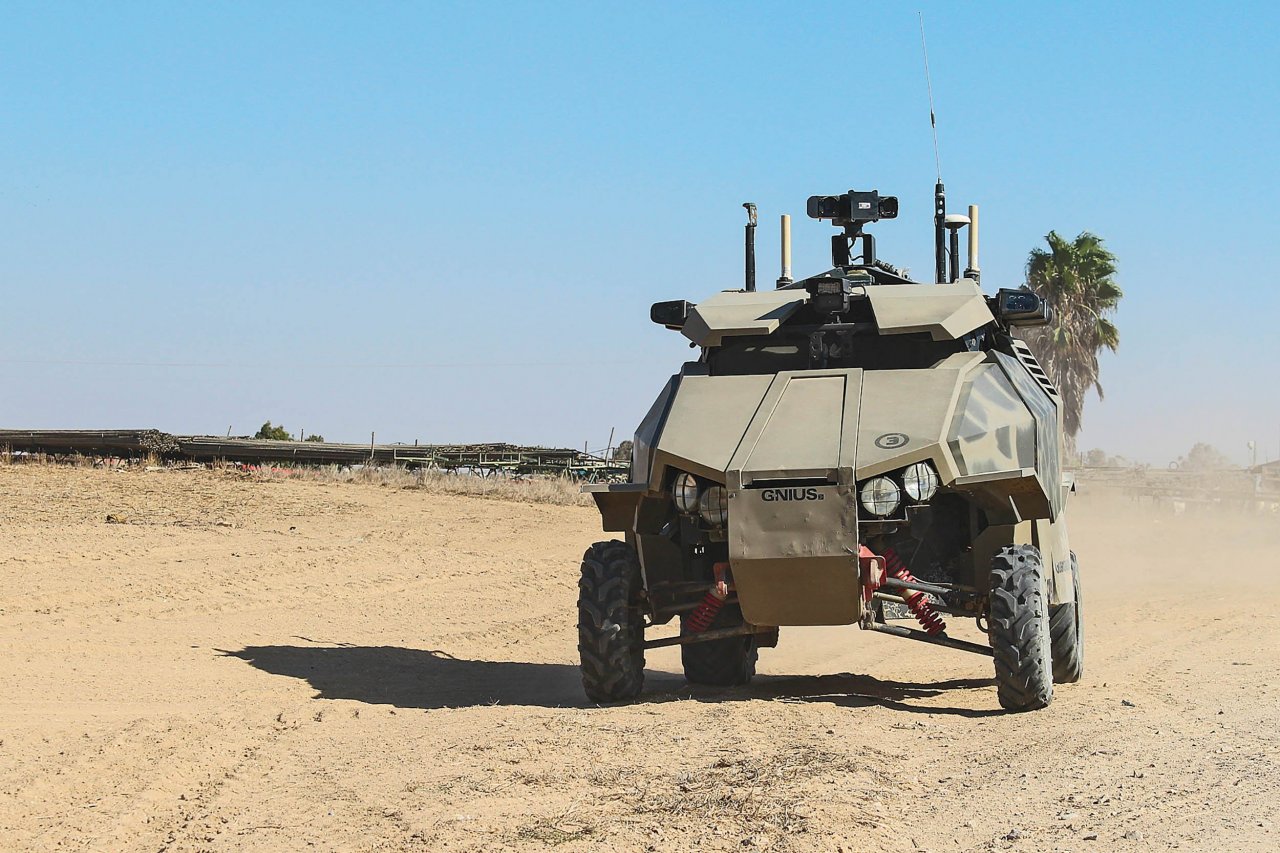They are the future of war—and no army will be complete without them. Israel recently became the latest country to deploy unmanned ground vehicles (UGVs). The Israeli Defense Forces' "Loyal Partner" is an UGV operated by soldiers at a remote location—a ground drone, in layman-speak, which has many sister machines.
Defense giant Oshkosh, for example, has developed self-driving technology that allows military vehicles to see better than humans in murky combat conditions. It's now being tested by the United States Marine Corps. With the U.S. Army, the Marine Corps recently conducted two tests on self-driving technology developed by Lockheed Martin, another leading defense contractor. Lockheed Martin has also developed a self-driving vehicle, as have Mesa Robotics and QinetiQ North America. All were tested by the U.S. Army last year. And "AlphaDog" (a.k.a. Legged Squad Support Systems), an animal-like four-legged robot developed by the Defense Advanced Research Projects Agency and the defense company Boston Dynamics, can carry 400 pounds of equipment and walk for 20 miles before it needs to be refueled.
The British Army recently purchased 60 "Terriers"—armored digging vehicles designed to breach enemy obstacles and excavate ditches and trenches. Though typically manned, the Terrier can also be operated remotely. "UGVs provide significant advantages on the battlefield," a representative for Britain's Ministry of Defense says. "They provide freedom of maneuver and protection for our personnel from explosive devices on the ground through specialist search and clearance functions."
Next year Israel will add a second class of UGV, the "Border Protector," which replaces the "Guardium." Both patrol the Gaza border, detecting bombs and "listening" for gunfire and figuring out which direction it's coming from.
Welcome to a new era of warfare. "UAVs"—what we think of as drones; the A stands for aerial—"have had a revolutionary effect on air warfare and counterterrorism, and UGVs can have the same effect on ground warfare," predicts Ben Barry, a former brigadier in the British Army. Britain has long used UGVs such as "Wheelbarrow" and "Panama" for bomb disposal, and for international forces fighting in Iraq and Afghanistan, similar devices have become an indispensable tool. According to a recent report by the Center for Strategic and International Studies, a Washington, D.C.–based think tank, the U.S. already has several thousands of ground drones in stock.
But the ground drones now being introduced play in a different league. Many of these vehicles can zip around war zones at up to 40 miles per hour, supplying soldiers with food and ammunition or disabling enemy bombs. In a recent trial, Oshkosh's technology allowed half the vehicles in a Marine Corps convoy to complete a rugged-terrain course without a driver, while vehicles fitted with the Lockheed Martin system completed the same task in a U.S. Army test.
The driverless systems have advantages: Lieutenant Colonel Armond Thomas, at the U.S. Combined Arms Support Command Science and Technology Division, points out that UGVs "avoid human endurance constraints," which means they can operate around the clock, remotely guided by soldiers. A human driver needs sleep in order to do his job properly.
The lowly supply convoy belongs to an army's most crucial operations. Even for a commander with superior combat forces, the game is over without a steady stream of food and ammunition. Yet supply convoys are also extremely exposed, traveling as they do in processions of several vehicles. As a result, Afghan and Iraqi insurgents target supply convoys with particular zest.
Recently, militants in the city of Peshawar, Pakistan, attacked a NATO supply convoy traveling to Afghanistan, killing two drivers. Last year, six soldiers were killed in a similar attack in Pakistan's Khyber tribal region. Between 2003 and 2007, over 3,000 American soldiers and contractors were killed in attacks on supply convoys in Iraq and Afghanistan. Jessica Lynch, perhaps the Iraq War's best-known prisoner of war, was captured after an Iraqi attack on a U.S. supply convoy.
The help ground drones provide to supply convoys will allow commanders to assign supply convoy soldiers to combat tasks. "Autonomy-enabled systems are, in essence, force multipliers that allow us to respond effectively to a broad range of missions and changing threats with appropriate, flexible and responsive capabilities," explains Paul Rogers. He is director of the U.S. Army Tank Automotive Research, Development and Engineering Center, Lockheed Martin's partner in developing the self-driving technology that can be installed in the military's existing vehicles, turning them into UGVs.
Armies will, in other words, be able to fight wars with fewer soldiers. That means fewer body bags returning home. "One of the big drivers behind this development is the desire to reduce casualties," explains Barry, who is now a senior fellow for land warfare at the International Institute for Strategic Studies, a London-based think tank.
As far as John Urias, president of Oshkosh and a former major general in the U.S. Army, is concerned, ground drones are any commander's godsend: "One of the most traumatic experiences a commander goes through is losing soldiers' lives," he notes. "But you can always replace a vehicle."
Taking the soldiers out of harm's way makes eminent sense, and today's advanced software and cheap computing makes the goal feasible. At the current rate of development, American vehicle-sized ground drones may soon join Loyal Partner and Terrier in real-life operations. And in a world with a growing number of insurgency-type conflicts, featuring plenty of suicide attacks and roadside bombs (improvised explosive devices), sending unmanned trucks to deliver supplies on their own is a highly attractive solution. All the warrior of the future requires is access to energy and a radio-wave remote-control device.
But the versatile, human-like and yet expendable ground drone may also change the very nature of warfare.
"Traditionally, the number of potential casualties has been a limiting factor in gaining public support for military action," notes John Kaag, an associate professor of philosophy and global studies at the University of Massachusetts, Lowell and co-author of the forthcoming Drone Warfare. "UGVs perform many of the functions ground troops have performed until now. With UGVs available, decision makers don't face as many risks when going to war."
They also create a new risk: Deploying ground drones could also cause confusion about whether a military conflict is underway. Does the arrival of an AlphaDog or Loyal Partner constitute an act of war?
The prospect of UGVs facing off against humans also raises the question of when it's fair to use UGVs. A UGV-equipped army fighting insurgents is hardly a fair fight, since the insurgents have to square off against machines that feel no pain. But once a country has ground drones, the public will expect that they, rather than soldiers, will be used. Insurgent groups, predicts Barry, will then try to develop their own ground drones.
The next step, explains Oshkosh's chief unmanned systems engineer, John Beck, is to fine-tune the technology to the point where the enemy can't detect whether a vehicle has a driver. Otherwise, the enemy would simply target the human-driven vehicles, eliminating the benefit of self-driving ones. But the development doesn't stop there. At a U.S. Army test last year, ground drones approached selected targets, fired at them and returned back to "base"—a next step toward an actual UGV fighter. Using robots rather than humans would, of course, enable armies to conduct wars with even fewer casualties. But a human thinks and ponders the consequences before pulling the trigger. Robots, even when piloted by soldiers, make no such calculations. That could increase violence rather than limit it.
"We are," Kaag admits, "many years from a military mission in which UGVs approach what experts call 'lethal autonomy,' but that means that it's precisely the right time to broach the question: Who is responsible when a human commander gives an order to a droid that in turn carries out a lethal action? That time is coming—and faster than we think."































